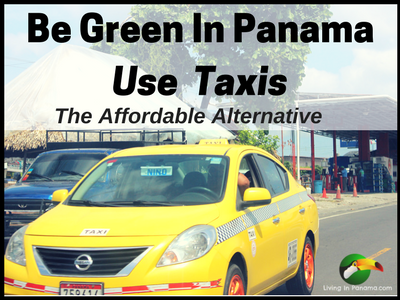
The majority of expats who live full-time or part-time in Panama drive their own, personal car.
And why not.
The highway system is being improved every year. There are thousands of miles of brand new, smooth asphalt to drive, and often there are few cars to share the road with.
Cars in Panama are relatively inexpensive and there is a good used car market (Please see our previous articles on purchasing a used car in Panama).
However, not everyone who moves to Panama wants a car. There are some very good reasons for not owning one.
Expense
Probably the number one reason most people choose not to own a car is the expense. As in the US, owning and operating a car requires that you purchase, and maintain your car. You need to buy fuel. You need to register your car. You need insurance. You need to buy new tires, wiper blades, etc…etc… Plus, you need to be financially capable of paying for the occasional major repair. This can be expensive as well as being stressful.
Being Green
The most obvious reason for not driving a car is that cars are very destructive of the environment. Regardless of your beliefs about irreversible global warming due to burning fossil fuels and the emission of huge amounts of carbon dioxide, and other greenhouse gases into the atmosphere, we can all see the vast impact that our use of the car has on our planet. Can you believe that people have been here for six million years or so, and that cars have only been around for a little over 100 years?
So, if you are on a tight budget, or you just want to do your part to preserve the environment, there is good news. You can simply “grab a cab”.
You will find the typical yellow-painted 4 door Toyota, Hyundai, or Kia cabs circulating throughout Puerto Armuelles all day, and much of the night as well. It shouldn’t take more than a minute of two to hail a cab on the street in Puerto Armuelles, or anywhere in Panama.
Taxis Are Cheap
Another bonus. The ride is cheap.
Puerto Armuelles Example
Most destinations in our town can be reached for less than $1.00. Even to get out to the beach at Corazon de Jesus might set you back $2.00. When you first arrive in town, you might find that cab drivers overcharge you a bit. However, once you learn the fares, you won’t have a problem. Everyone pays the same price, expats and Panamanians. Shared taxi rides (where they pick up other people on the way) are less expensive than your own exclusive ride.
Although Betsy and I drive a car, I still maintain contact information for 3 or 4 cab drivers in my phone. Good to have for emergencies, or just if you want something picked up and delivered.
If you don’t have a car, and you always want to be confident of having reliable transportation, you might want to keep as many as 6 or 7 cab driver contacts. That way, you can have phone numbers of favorite cab drivers who drive during the day, and numbers of favorite drivers who work the graveyard shift.
If you wish to go to David, the current price for one passenger is $30-$35. It’s the same to the international airport in David. Or, you could take the bus to David for $4, and then take cabs in David to do your shopping. Then return to Puerto by bus, or by cab one-way. Alternatively, if you have a lot to accomplish in David, you could take a bus, run errands by cab, and spend the night in a hotel (See article on a good hotel in David). Then return to Puerto, fully rested, the following day.
In Panama City, there are even more alternatives like its many buses, its subway, taxis and more. Uber is particularly popular in Panama City. It is not offered anywhere else in Panama yet.
My curiosity has been piqued by the big boom in the use of electric bikes in Seattle. One might employ some combination of bicycle, electric bike, or scooter, and taxi cab in your daily life. This way you could easily cover all of your transportation needs in Puerto Armuelles. One could enjoy a flexible, economical, and convenient lifestyle this way.
If you like being green, you should check out our Living In Panama house, an affordable non-air conditioning dependent home.
[leadplayer_vid id="58FF854299CB2"]
The video above was done by elsalvador.com
Tamborito evolved starting in the 17thcentury after the Spanish conquistadors brought slaves to Panama. The slave dance culture blended with the Mestizo (mix of Spanish and Indian) dances to establish a new dance. One that involved percussion instruments, clapping, singing, and lively choreography.
The dance is a romantic courtship between a man and a woman.
The basic choreography of the dance consists of shuffling steps. Every person who wants to dance creates a circle, men on one side and women on the other. Taking turns, one man and one woman will go into the center and dance with subtle movements of their hips and tiny steps. They may dance next to each other or face to face but never touching. Typically there are at least 6 couples dancing.
The male dancer works to impress the woman with fast footwork and by gesturing with his hat. He dances in a circular pattern- almost as if he is chasing her. The female dancer also moves in a circular pattern in accordance to the man. She holds her pollera (skirt) in both hands, letting the long fabric create a bell shape, as she moves gracefully as if gliding across the floor. At times the empolleradas provocatively swish their long flowing dresses. After inviting him closer in this way, she will spur him by turning her back and continuing her circling dance.
Professional Panamanian folk dancer Dimaris Bergeron says that eye contact is key to any Panamanian folk dance between a man and a woman. The woman is not supposed to smile because that would imply that she finds the man charming. It is a playful dance with the man trying to entice the woman while she resists his appeals.
The men are called montunos named after the straw hat that they wear. The women are called empolleradas named after their long skirt.
At the end of the dance, the partners curtsey to each other.
NOTE: The description of the dance above and the customs below are for the more staged and formal performances. Tamborito often occurs much more spontaneously or casually. Much like the video of Tamborito above.
Tamborito music incorporates Panama's African influences. Tamborito means “little drum”. The rhythm is referred to as “Tambor Norte”.
The Tamborito is played with three small drums, one for the high tones, one for the low tones (and a caja), another one for the rhythm. They layer their sounds on top of each other.
Depending on the region, it may also include a Spanish guitar, a violin and an almirez. The almirez is a metal mortar and pestle that is used as a percussion instrument. The instrument is historically Arabic.
There is usually one female lead singer who is supported by rhythmic chorus clapping and singing of the rest of the women. The lead singer, cantalante, may sing about life, work, or love, depending on the type of tamborito.
An important aspect of the dance is the costuming. Women wear La Polleras. A La Pollera is two separate pieces: a shirt and a Pollerón (long skirt). The gowns are detailed with colorful embroidery, lace, and ribbons.
On top of each female dancer’s head rests a large elaborate headdress called a tembleque.
The head decoration is almost as important as the dress itself. The hair is parted into two braids and tightly pulled back behind the ears. The head is decorated with tembleques. They are designed to sparkle. (see photo below).
The tembleques are applied with various types of combs. There can be as many as twenty combs on the head -ten per side. The woman also wears ornate and reflective jewerly (see photos below).
The men’s costume consists of a
There are different patterns of shirt, pants, and shoes, according to the region.
Click on photos to start slideshow.
The Tamborito is especially popular during the Panamanian Carnival, a national celebration that takes place between February and March, just before Lent begins.
Sources:
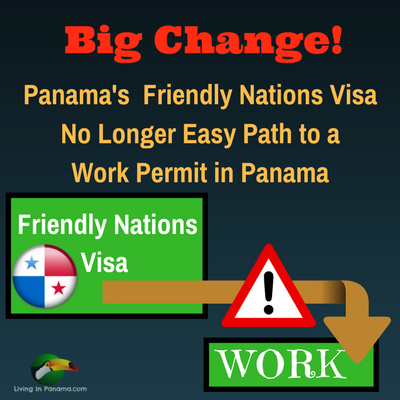
On February 15, 2017, the Ministry of Labor issued a new work permit requirement for foreigners with either a Friendly Nations or Professional Foreigner visa.
To apply for a work permit, those visa holders must now have an approved and stamped employment contract with a Panamanian company and be enrolled in the local payroll system.
This is a big change. Before you did not have to have a job in order to get a work permit, at least not for holders of a Friendly Nation visa.
This is a big set back for people who simply wanted to work in their own business. For instance, a foreigner can open a restaurant in Panama. But if you also want to wait tables at your restaurant, you need a work permit. (Please consult a good lawyer to get a full picture on how this new regulation may impact you.)
Of course, there are other ways to get a work permit.
The Friendly Nations visa was originally created in 2012 to attract more skilled workers to Panama. There simply were not enough skilled Panamanian workers to meet the need of local companies. To remedy this, government created the Friendly Nations visa and explicitly linked it to an expedited work permit process.
But the recent uproar over rising number of illegal workers in Panama has put a halt to that. Recent and significant changes to Panama Tourist visas have also been made to help stop the influx of foreigners working here illegally.
The Friendly Nations Visa itself doesn't give you the right to work, so it may not get caught up in this drive to curtail foreign workers. However, given the public sentiment, it may go away. If you were thinking of applying for one, it is better to apply sooner rather than later - or too late.
The official government site explains what you need for a work permit with the Friendly Nations Visa. However, what that site says or the exact wording of the law may not determine how your work permit application is treated. There is an interpretation that the law, and that interpretation is still in flux. But for now it seems that unless you had your work permit application in before March, you won't be getting one. That is, unless you have a job offer from a qualifying Panamanian company.
Find out more about the Friendly Nations Visa here
The good news is that Friendly Nations and Professional Foreigner visa holders will still not be considered in calculating a company’s foreign-to-local worker ratio. This is still true even though these visa holders must now have a local employment contract and be paid through a local payroll.
This means that those visa holders will still have an edge on getting a job with a local company since they won't impact the company's ratio numbers.
(FYI, Panamanian laws establish that only 10% of a company’s work force can be foreign (non-Panamanian); exceptions include if a worker is married to a Panamanian, or if the worker has lived in Panama for 10 or more years).
This easy link between the Friendly Nations visa and a work permit is an innocent victim of public outrage.
Panama has experienced an alarming rise in foreigners, on a tourist visa, who are working in Panama. It is illegal to work in Panama if you are on a tourist visa. Until very recently, these foreigners, mostly from other Latin American countries, only needed to hop over the border to renew their tourist visa. And then go back to their jobs.
Panama has now made changes to tourist visa regulations to eliminate this easy visa renewal border hop. It was a good move.
However, this work permit change seems like a knee jerk reaction to the public outrage over the illegal workers. Making it harder for holders of these 2 residency visas to get a work permit does not help eliminate illegal workers. Foreigners who apply for a work permit, obviously want to work legally. By further restricting the ability of foreigners to get a work permit, they only make it more tempting for them to work illegally in Panama.
The easiest way to make money while living in Panama is to earn it outside-of-Panama. You can work online in various capacities, work your job remotely from Panama, and other ways.
In a previous post, I wrote up some ideas on how to make money in Panama .
Check out these beautiful & affordable properties
These properties have some of the lowest per meter prices you will find in Puerto Armuelles – or in Panama.
Updated: March 24, 2017
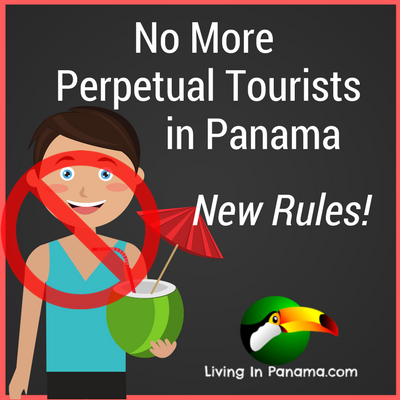
As of March 6th, you cannot renew your Panama Tourist Visa, unless you leave Panama for at least 30 days.
That's right you must leave for 30 days.
Don't worry, you are exempt if your residency visa application is being processed.
However, for those applying for residency, make sure you are given an ID showing that your residency is in process. Without that ID you need to comply with the new Tourist Visa regulations.
It is the steadily increasing number of people working on a perpetually renewed tourist visa that sparked the uproar.
I don't think the changes are prompted by North Americans doing this. In my opinion, it is the perpetual "tourists" from other latin american countries that caused this massive rule changes. (The government has also changed some work permit rules.)
When I was in Panama City last month, most of the waiters I talked to were from Nicaragua or Colombia. I was told that the authorities have been increasingly making surprise visits to businesses and asking to see all the workers work permit documents. The large number of illegal workers has been a growing government concern.
Given that Venezuelans were the primary subject of most of the initial border crossing stories there may even be more Venezuelans than other nationalities working illegally in Panama. But whether that is true or not, the new rules are apply to all tourists, regardless of their country of origin.
In general, Panama is very protective of jobs for Panamanians. For instance, there are 25 categories of jobs that foreigners are forbidden to hold by Panamanian law. It is also why they have also recently changed how easy it is to get a work permit for friendly nation visa holders.
So it is not surprising they are coming down hard.
There are increasing numbers of people working in Panama, illegally, on a tourist visa.
Need a residency visa? Here are 4 Panama visas you may qualify for.
Even before this rule change there was a number of reasons to get residency in Panama.
90 vs 180 Day Tourist Visa
For citizens of some countries, Panama will now only issue a 90 day tourist visa. It was President Varella's predecessor, President Martinelli, who lengthened it to 180 days.
In Varella's Executive Decree No. 590 he shortened it back to the 90 day tourist visa.
However, in Decree No. 591, of the same day, Varella made an exception to the 90 day tourist visa for citizens of countries which are not required to get a tourist visa BEFORE they arrive in Panama.
Therefore, citizens of the US, UK, Canada, Australia, and many other countries will be issued an 180 day tourist visa. This page of wikipedia has a list of all the countries which are not required to have a visa to visit Panama. If you hold a passport from any of those countries, you will be issued a 180 day tourist visa in Panama.
(Note: you can only legally drive a vehicle for first 90 days on a tourist visa, even if you have a 180 day visa.)
30 Day Exit
The biggest change to the tourist visa is its renewal policy.
Now, to renew a tourist visa (both 90 and 180 day visas) tourists are required to leave Panama for a minimum of 30 days before reentering Panama.
Legal Residents & Applicants
If you are a foreigner (e.g., American, Canadian...) with legal Panamanian residency this does not impact you. A foreigner with legal residency in Panama is not required to stay outside the country x number of days before being allowed to re-enter.
Again, if you have applied for your residency visa, but don't have it yet, you should receive an ID showing that your residency is in process. If you have that ID, you are also not required to stay outside the country x number of days before being allowed to re-enter. (Note, if you don’t have this ID, then you should leave Panama before your tourist visa ends.)
Keep in mind, that the officials at the border crossing don't always understand the rule changes themselves. Always be polite and gracious. If you need to, simply ask to see their manager.
Here is the email that the American Citizen Services department of the US Embassy in Panama sent out about these changes.
The U.S. Embassy in Panama would like to inform all U.S. Citizens in Panama that on March 6th 2017, the Panamanian Immigration Authority (Servicio Nacional de Migracion-SNM) announced new guidance for Panamanian immigration officials on the enforcement of pre-existing regulations.
According to the SNM, immigration officials have been instructed to be stricter about the enforcement of the regulation that foreigners entering Panama with tourist status prove that they are in fact entering Panama as tourists and not residing in Panama.
Since the announcement, the Consular Section has received many questions from U.S. citizens about this new guidance.
Below are the most frequently asked questions along with the responses the Consular Section received from the SNM.
Should you have further questions, please reach out to the SNM directly via phone at507-1800 or visit their website at: http://www.migracion.gob.pa
In order to re-enter Panama on tourist status, does a U.S. Citizen need to return to their country of origin (the country from which they came into Panama) or can they return from a third-country (example: Costa Rica)?
Answer: In the new guidance SNM does not specify if the tourist needs to return his/her country of origin. What is being implemented is that, in most cases, the person needs to leave Panama for a minimum of 30 days before reentering as a tourist.
In order for a person to re-enter Panama on tourist status, what is the minimum amount of time the person needs to spend outside of Panama?
Answer: The new requirement that is being implemented by SNM in reference to time spent out of Panama is a minimum of 30 days before applying for admission, in most cases.
In order for a person to re-enter Panama on mariner visa status, what is the minimum amount of time the person needs to spend outside of Panama.
Answer: According to SNM, mariner visas are valid for 90 days and must be renewed on the 90th day, or the day before, from the date of the previous mariner visa stamp. Mariner visas can only be renewed once before the visa- holder needs to exit Panama. The amount of time the person with the mariner visa needs to stay outside of Panama is not specified by SNM.
If entering Panama on tourist status, does the method of entry need to match the method of exit (i.e. can a U.S. Citizen enter Panama on a plane and use as proof of exit evidence that they own a boat in Panama and plan to exit via boat)?
Answer: The method of entry and exit into and out of Panama does not have to be the same so long as the entries and departures are met legally by using established Ports of Entry – land, maritime or air and admitted by a Panamanian immigration officer.
Do U.S. Citizens with legal Panamanian residency status also require a roundtrip ticket when entering Panama?
Answer: No. A foreigner with legal residence in Panama does not need to show proof of exit from Panama.
Is a person applying for Panamanian residency required to stay in Panama for the entire duration of time required to complete the residency process? If so, what happens if the process takes more than the allotted six months for tourist status.
Answer: If the person has an ID that shows that his/her residency is in process, the person is fine to leave and return to Panama. If there is no ID, then the person should exit as a tourist (i.e., before the sixth month approaches).
How long does the FBI Identification Record process, required for purposes of obtaining residency in Panama, take? Can this process be expedited?
Answer: For information on the FBI identification record process, individuals may visit https://www.fbi.gov/services/cjis/identity-history-summary-checks. According to the FBI website, the current turnaround estimate for these records is 12 to 14 weeks plus the amount of time the results may take to arrive in the mail. Currently there is no option to receive the response electronically. For questions on this topic, individuals may call (304) 625-5590 or write an email to [email protected]
Tourists are only allowed to drive in Panama for 90 days. Is there an exception for this given that tourists are allowed to stay in Panama for 180 days?
Answer: According to the Transit authority (http://www.transito.gob.pa/sites/default/files/reglamento_decreto_640..pdf) foreigners that enter Panama as tourists are not permitted to obtain Panamanian drivers’ licenses and are only allowed to drive with a foreign license for 90 days. There are no exceptions to this rule.
Can SNM waive the FBI Identification Record process if a person does not exit Panama for two years? If so, would there be an exception to the 180 day stay limit for tourists for a person trying to obtain this waiver?
Answer: If a person stays in Panama for more than two years then the FBI requirement does not apply. The waiver of the FBI requirement applies to those people that stay in Panama two years, without exiting. In these cases, a fine is paid by the person for overstaying their tourist visa and the person is only required to present a PNM police record rather than the FBI check.
You can find all the decrees and laws that affect immigration at Panama's department of immigration (Servicio Nacional de Migración de Panamá or SNM). You can visit their website or call them at 507 1807 or 507-1822.
Do you want to live long term in Panama?
Explore out our affordable Puerto Armuelles real estate.
[justified_image_grid lightbox=photoswipe mobile_lightbox=photoswipe lightbox_max_size=large]
The weekends will be especially crowded. More than 300K visitors are expected this year. The David Fair has all sorts of things: horses, cows, car and tractor dealerships, plants, traditional dancing, and much more.
Handicrafts, Art, Furniture
If you are looking to buy some handicrafts, paintings, furniture, or hammocks is it worth your time to check out the stalls. There are both outdoor and indoor stands of a wide variety of merchandise.
Gardening
If you are a gardener, make sure you check out the area of the fair where they sell plants. There is an enormous variety of plants for sale. You may want to go during the day, when it is less crowded.
I believe admission still only costs $2 , $1 if you are retired. Admission is free if you are under 8 years old. If you want to see the "zoo", it is an extra 50 cents, which you pay at the zoo entrance.
I have written about the David Fair a few times in the past. If you are interested, here the links to those posts.
2012 visit including 2 hotel mentions

David is also conveniently located for day trips to visit Puerto Armuelles, Boquete, Volcan or Boca Chica, etc.
Sometimes even if you live in Chiriqui, you may want to stay the night in David. Those of us who live in Chiriqui, will go to David for all those items you cannot find anywhere else. Often, all those saved up errands turns into a very long day.
For example, if you are like us, you don’t drive to David very often. When we are in Seattle, we can run most of our errands in our own neighborhood. We don’t drive very much. Or, when we do drive, we take very short trips. We live a similar lifestyle in Puerto Armuelles. We can find almost everything we need, throughout the year, in Puerto. Everything from a very good grocery store, fresh fish and produce direct from the fisherman, or the farmer, to at least a half dozen building supply stores, to printing, copying, office supplies, etc.
We only go to David for things for some meetings or we sometimes need to buy parts for one of our cars that are not available at the frontera (Paso Canoas). There are also oversized (Architectural blueprint size) printers available in David. Full size plan sets are required for building permits in Panama.
There are 2 places to get oversized copies. Oficentro, a block east of the Central Park or Librereria Daisy, about two blocks north of Oficentro. (We are big fans of Oficentro. It sells a big assortment of art supplies, office supplies, jewelry, hair accessories and more.)
One of our David errands is PriceSmart. PriceSmart is Panama’s Costco.
We go there for various items, such as huge bag of dog food, Ghirardelli brownie mixes, frozen pizza, printer ink, Serrano ham, fresh mozzarella cheese, and more. When we go to PriceSmart, particularly if we are hungry and tired at the end of the day of errand running, we often come home with things that we really didn’t need. This is especially true because our family of 4 is more of cranky shopping committee at the end of a David trip, than a focused couple or single shopper.
PriceSmart is located on the highway Inter-Americana, 2 of kilometers south of the central part of David.
Occasionally, we have decided to spend the night in David after a long day of errands.
When we do our PriceSmart shopping trip that next morning we find we both don’t buy too much and don’t forget crucial items. The savings we gain from not over-shopping at Price Smart after a overly long day in David covers our hotel stay. So, a simple overnight stay in David can be good for family relations, even for one’s marriage. Amazing!
Plus you may find yourself needing to stay over night, or driving back the next day. Sometimes a meeting with a lawyer or notary in David, proves to be a 2-day thing.
The papers that were supposed to be available for signing quickly are not available. Or, the person running the agency where the papers are needed, suddenly remembers that there is one more “critical” document that needs to be signed in triplicate in order for a certain legal, bureaucratic process to move forward.
“Don’t worry: I’ll have the papers ready for you first thing in the morning”, says the smiling notary, or secretary, lawyer, etc.
We have all heard this on more than one occasion.
For those of us, who do not like to drive, the idea of driving all the way back home to Puerto Armuelles (1-1/4 hours, one way) only to turn around and do the trip again the very next morning, is well worth the $50, or $60 for a comfortable hotel. (Puerto Del Sol is an affordable & comfortable hotel in David)
The small capital city of our province does not provide much of an attraction for those of us living elsewhere in Chiriqui. However, it is occasionally necessary to make the trip to David.
By taking an extra half day to complete all of our tasks in David, we find we are much less stressed and tired. The trip is then even be enjoyable, or at least comfortable.
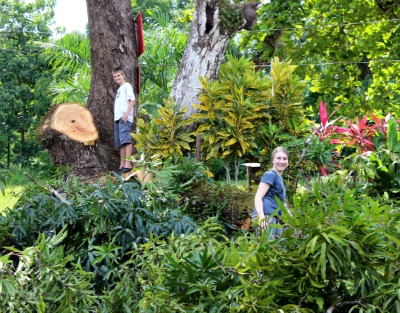
If you are Panamanian, you are much more likely to get away with it. Well, unless you have a neighbor who doesn't like you, or if the tree cutting damages your neighbor’s property.
It is the law.
Expats are expected to, and should, follow the letter of the law here. It is a sign of respect. A neighbor, or even a passerby, is much more likely to turn an expat into the authorities, than a local. Mostly, because it does seem disrespectful for foreigners not to follow the law.
You really do not want to gain a reputation for being someone who doesn’t respect the laws of your new country. It is a reputation that will only make your life more difficult.
Trees are considered a valuable resource in Panama. They are used for buildings and furniture. Their fruit and nuts are a valuable commodity as well.
And the reality is that deforestation is a real problem here. The climate of the Azuero Peninsula radically changed after they cut down most of their trees to expand cow farming. While your back yard trees are not part of the deforestation issue, the regulations to protect Panama's forests and tree resources, include you and your trees.
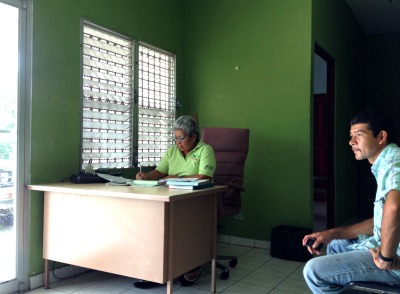
Panamanian law states that you must get a permit to:
You can request both permits at the same time.
You can be fined, if you cut down a tree without a permit. The more trees you cut down, the more you will be fined. Of course, someone has to complain for you to be fined.
The threat of fines does seem to keep people from harvesting trees for money, at least in areas where they are not likely to be seen felling a tree.
An Illegal Tree Cutting Experience. We had a neighbor, an expat, of one of our properties cut down 200 of our trees! The trees were all over 4" in diameter. We had planted them to block the sight of his cell tower. Unfortunately for him, the tees also blocked his ocean view.
While we were out of the country, without attempting to contact us, he decided to cut them all down. When we asked him about it, he claimed that his gardener said, "it was okay to cut them down". Yeah, it was the gardener's fault.
Although, we had ANAM come out and verify the number and size of the trees that he cut down, we did not press any charges. Given the number of trees, the fine would have been quite substantial. While were miffed and mystified about the incidence, but trees are easily grown here. So we decided to let it go. We simply replanted.
We have cut down a few trees in Panama over the years. Usually because the tree was in some way hazardous. For instance, when coconut palm trees get over a certain height, they are dangerous. A coconut falling from up high can kill someone.
Of course, we have also planted over ten thousand trees. We love both the ease of growing as well as the variety of trees here. We usually plant trees for shade, architectural interest, property boundaries, as well as fruit trees for their fruit.
Getting a tree removal permit is:
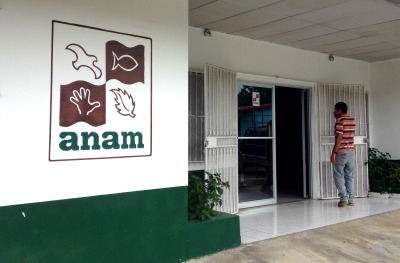
Required Documents
You must submit the following documents to your local ANAM office.
We typically ask our tree cutter to take his aserrador’s (logger) license to the ANAM (Environmental and Marine Administration) office to apply for the permits. We give him all the required documents above. It is much easier that way, as we discuss later in this post
You can apply for up to 5 trees to be removed per permit request.
ANAM in Puerto Armuelles: The ANAM office in Puerto Armuelles (see photo above) is 1 block south of the baseball stadium in Rio Mar neighborhood (on the same street as Pizza Pilo).
In addition, once you (or your tree removal guy) hands over all the required paperwork, you need to formally request an inspection of the property by an ANAM engineer.
The engineer usually comes out to visit the site very quickly: That day or the next. Then he returns to his office, fills out, signs, and stamps the permit.
So far, we have never had any request to fell trees on our property denied.
The property owner then goes to the ANAM office and pays the $13 permit fee. Make sure you leave with the permit in hand.
You then should give the permit to the person who is actually cutting down the tree.
Panamanian law requires that the tree felling permit be in the hands of the tree cutter, just in case of a surprise site inspection.
However, we have never had a follow up inspection in over 10 years of living in Puerto.
The whole process sounds arduous. In reality it is not.
Generally, this entire process can be accomplished in a day or two.
We have obtained our own permits many times.
We used to go to the office ourselves (well, Reyn usually went). Then it did feel arduous.
We find that having the guy who wants to do the tree removal (this applies to all kinds of contracts and contractors) apply for the permit himself, speeds the process up.
The worker knows the engineer. The engineer knows that the worker needs the work to feed his family. It makes it much less likely that there will be any bumps along the way. It is a “done deal”.
Of course, when we did it ourselves we never had a problem, though it did seem to take more time to get the permit. We don't want to discourage you from getting your own permits, but it is something to consider.
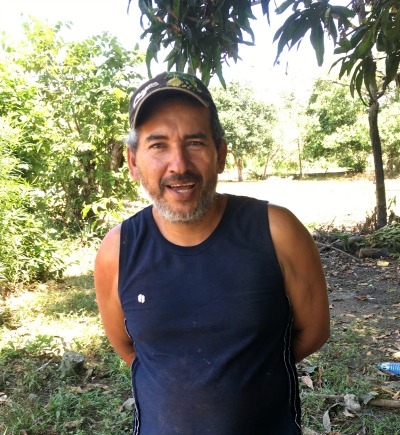
Our Tree Removal Guy - Lalo
Typically, we have Jose “Lalo” Samudio get the tree removal permit for us.
Lalo is a logger/tree remover here in Puerto Armuelles. Lalo is a licensed logger (“aserrador”). He also owns a tractor which is very helpful in the tree removal biz.
Lalo is also a competent woodworker, logger, backyard mechanic, and jack-of-all-trades. In short, Lalo is very handy guy to know. Plus, he has a lovely family, with a wife and three children.
In case you want to hire him, Lalo lives on a corner lot in the Coronado neighborhood, which is just north of the Corazon de Jesus neighborhood. Ask around and someone will point out his house.
Getting a permit will cost you $13 and about 2 days of waiting.
Most importantly, it helps you maintain good relations with both your neighbors and local officials.
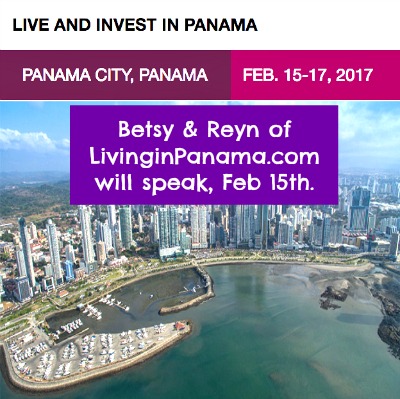
So, on Feb. 15, Reyn and I will share why and how we decided to live in Panama.
And, most importantly, what it is really like to live here in Panama.
The Live and Invest Overseas (LIO) literature about the conference is a bit over the top.
But it looks like the hype could be limited to getting people to attend the conference.
They even magnify the benefits of the accommodations. For instance, in their conference sales page, they state you save money because their special hotel rate includes free breakfast and free wifi. They assert "Internet alone can cost you US$30 a day at some hotels!" However, I have stayed in Panama City countless times and have never been charged for wifi, and almost always breakfast is included in my stay. You can see their sales page here.
However, in no way has LIO asked us to sugar coat or hype our presentation. They simply asked us to share what we would typically share about living in Panama.
So that is our plan. Our talk will be the straight scoop on our experiences moving to and living in Panama.
If possible I will tape our presentation and share it with you, our readers.
Our plan is to attend most, if not all, of the conference.
Neither of us have ever been to an event like this. I am very curious about what is presented and whether it seems realistic. Also, we want to be around to answer attendees questions.
I will write about our impressions when we return.
Although, we have never been to a LIO (or any) Panama conference, we have been in communication with them.
Back in 2013, 2 young men from Live and Invest Overseas came to do a report on our town, Puerto Armuelles. You can read about Live and Invest Overseas' visit to Puerto Armuelles, Panama.
Also, Reyn and I once interviewed Lief Simon of LIO via Skype about his Panama experiences. We put together a video in which he talks about the cost of living in Panama.
Have you been to a conference like this one before?
What was your experience? would you recommend it to a friend?
Please share in the comments below.

Don't worry, you can get your benefits reinstated. Start with an email, as I explain below.
Keep in mind, most people only need to submit this form every other year. (See submittal requirements below)
Do you receive benefits from the US Social Security Administration (SSA)? Then you were required to submit a Proof of Life form in 2016, if you meet any of the conditions below:
(note: If your SSN ends in 50 -99, you must submit the "Proof of Life" form in 2017, not 2016)
In May/June of each year these forms are sent to the mailing address you have on record with the SSA. A second request is mailed in October.
This is why it is important to keep your address updated with SSA.
If you were required to submit your proof of life form to SSA in 2016 but haven't, you should e-mail the Federal Benefits at [email protected] .
Ask for them to email you a "Proof of Life" form and instructions on how to get your benefits reinstated.
More Information
I have written more extensively on the required SSA Proof of Life form in a previous post.